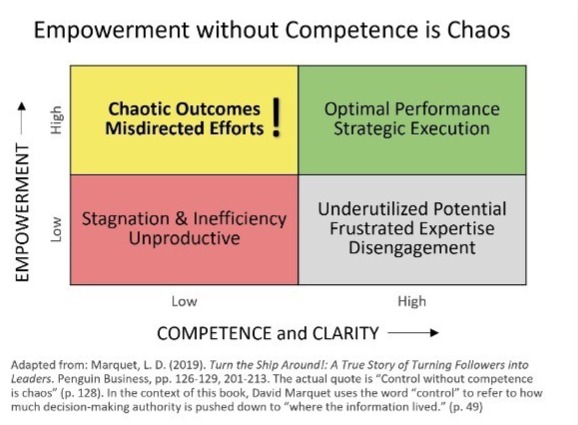
In the realm of project management, empowerment is often elevated to a supreme virtue. Leaders are encouraged to distribute decision-making authority throughout their organizations, fostering a culture of autonomy and innovation, particularly within Agile methodologies. However, as L. David Marquet aptly illustrates in his insightful work, Turn the Ship Around!, empowerment without competence can lead to chaos. Moreover, having competent individuals is not enough if they do not align toward a common purpose. Thus, leadership must establish two foundational pillars: the cultivation of competence in people and the clarity of purpose, before true empowerment can be realized.
Cultivating Competence
The first pillar of effective leadership is the cultivation of competence among team members. It is crucial for individuals to possess the skills and knowledge necessary for making informed decisions. This requires an investment in training, mentorship, and continuous learning opportunities that empower team members to confidently develop the expertise needed to fulfill their roles.
Marquet offers practical insights on how leaders can nurture competence within their teams. This includes encouraging experiential learning, where team members learn from both successes and failures. Leaders should foster a culture of open communication, welcoming questions and promoting knowledge sharing. When individuals feel supported in their growth journey, they are more likely to embrace decision-making responsibilities.
In our experience as managers, ensuring the competence of cross-functional project teams requires ongoing effort. This need becomes especially apparent when experienced team members leave and are replaced by those new to their roles. Team competence must be proactively addressed before crises arise. While technical proficiency is essential, it is equally important that these cross-functional teams possess the capability to operationalize the product development process throughout the project.
In the short term, a leader’s instinct may be to step in to cover gaps and direct the team through at-risk programs. However, this approach is temporary at best and can set a dangerous precedent. The real challenge for leaders is to take the necessary steps to help team members learn throughout the process, thereby preparing the workforce’s competence for the long term. Supporting team growth by aligning competencies with current and prospective future roles—coupled with coaching and encouraging experimentation—is a critical success factor.
Clarity of Purpose
Competence alone is insufficient if team members are not working together toward a shared outcome. Leaders must communicate the organization’s goals, values, and expectations clearly and understandably. When team members comprehend the “why” behind their tasks, they feel more connected to the organization’s mission and objectives. Understanding the end goals and the rationale enables them to prioritize efforts and make decisions that align with those objectives. This clarity enhances motivation and empowers team members to take ownership of their roles.
In complex product development, project teams often struggle without a clear understanding of objectives and priorities. While there may be considerable activity, it can be disconnected and fail to lead to well-informed decision-making. This disconnect often results in iterative work and loop-backs in the project, causing team frustration and disengagement. Our experience has shown that taking the time to establish clear and actionable objectives with peers and team members—while resisting pressure from sponsors and stakeholders to demonstrate immediate activity—can be challenging but essential. This practice cultivates clarity of purpose and intent, enabling teams to make rapid and effective progress.
The Responsibility of Leadership
Marquet emphasizes that leaders should shift their focus from merely directing people to creating an environment that encourages critical thinking and informed decision-making. This shift necessitates trust in teams and empowering them to take initiative, fostering a sense of ownership and responsibility throughout the organization. To be effective, leaders must concentrate on increasing the competency of team members while simultaneously providing clarity of purpose. Both pillars are crucial for effective empowerment.
The potential of this approach is immense: it can unlock the full potential of an organization. When distributed decision-making is supported by a clear purpose and a workforce equipped with the necessary skills, the organization can operate both effectively and adaptively. Leaders who invest the time and effort into ensuring clarity and competence build a resilient workforce capable of navigating challenges and seizing opportunities.
Conclusion
As project managers and leaders, we must acknowledge that empowerment, absent of competence, leads to chaos. By establishing a clear purpose and fostering an environment that cultivates competence, leaders can effectively distribute decision-making authority throughout their organizations.
The lessons from L. David Marquet’s Turn the Ship Around! serve as a powerful reminder that effective leadership is about guiding teams toward success—not merely by directing them, but by empowering them with clarity and supporting their development. By adhering to these principles, we can transform our teams and organizations into high-performing entities capable of achieving remarkable results.
Reflective Questions
What is the effectiveness of your workforce today? Does your work environment promote learning? Have you provided the clarity needed for your workforce to act purposefully towards a common goal? As a leader, where should your focus be to take the next step toward improved empowerment?
For those of you well up the empowerment curve, we encourage you to read Chapter 28 of Marquet’s Turn the Ship Around!, where he introduces the ultimate goal of moving beyond empowerment to a state he defines as emancipation. What additional steps are required from leadership to achieve that?
Co-written by Dan CAPUTO / Patricia LHOTE DE NEEFF

